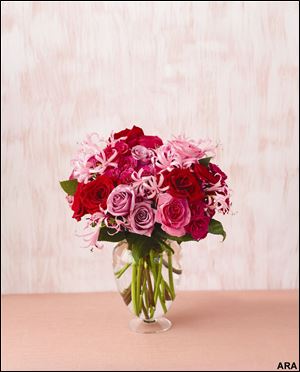
How to Maximize Your Enjoyment of Fresh Flowers
6/18/2010
In floral arrangements, Martha Stewart avoids high contrast colors, which can look static. She prefers colors that complement each other and lend richness and depth.
(ARA) - Warm weather is finally here, and there's nothing more beautiful than or as anticipated as the season's fresh flowers.
For lifestyle expert Martha Stewart, one of life's greatest pleasures is living in a flower- and plant-filled home. Stewart loves to arrange the flowers that bloom in her gardens and greenhouses, and to incorporate purchased flowers into her table arrangements. She especially likes to give garden-fresh cut flowers as gifts, artfully arranging them herself in one of her unique containers. Whether decorating for an occasion or remembering a loved one, fresh flowers always make the home feel special.
People love flowers but don't often indulge in the purchase because they are unsure how to arrange or care for them. Stewart and the professionals at 1-800-FLOWERS.COM offer some simple tips to help you discover the many pleasures of flowers, whether you are buying them or cutting from your own garden:
It's easy to enhance your flowers' unique personality by creating a lovely arrangement based on one of four basic styles. The nature of your flower's stem and blossom, as well as your choice of container, will guide you in choosing the right one.
* Domed arrangements display the blooms in an arching bunch. Mass them tightly together, crossing the stems within the vase to allow the flowers to point in every direction, creating a delightful dome of rich color. This arrangement is ideal for gerbera daisies, chrysanthemums and carnations.
* Spiky arrangements are best for long flowers with stiff, vertical stems, such as sunflowers, irises, French tulips and Oriental lilies. Create a dramatic effect by arranging them in a tall, cylindrical vase that holds them upright. This keeps a big display from looking too sparse.
* Free form arrangements allow flowers to reach and bend naturally. Cut the flowers at various lengths for a more organic look. Try combining flowers with sprigs of foliage in a relaxed cascade of color. This arrangement is ideal for tulips, roses, and freesia.
* Display arrangements in groups for a charming and spontaneous look. Use several small arrangements to create a single centerpiece by running them in a row down the length of a table. Any flower looks great in a grouped arrangement, from those with larger blooms such as Oriental lilies, roses, and dahlias, to smaller blossoms such as freesia, spray roses, and nerines.
It's important to keep it simple. Stewart avoids high contrasts, which can look static. Instead, she prefers colors that complement each other and lend richness and depth to an arrangement. She explores every aspect of her garden for inspiration.
Bouquets
All cut flowers and bouquets need food and water, so each stem will need to be re-cut, preferably underwater at a 45 degree angle -- shorn of leaves and arranged in a vase with tepid water. Add a flower food packet (or, if none is available, add one teaspoon of sugar, a squeeze of lemon juice -- or one aspirin -- plus one or two drops of bleach) and place away from drafts or excessive heat. Refresh every two to three days by re-cutting stems, changing water, and adding flower food.
Vases
A bouquet's vase should be carefully considered. The scale and material of the container must captivate the eye and showcase the flowers. In addition to traditional vases, Stewart uses everyday objects such as sugar bowls and creamers, measuring cups, metal buckets, compotes, and teacups to display her favorite blossoms. Vases and other containers can be divided into six basic forms:
* Trumpet: Fluted at top. Blooms fall and arch outward naturally, echoing the flare of the vase.
* Cylinder: May be tall or short. This type of vase is good for stems that need support or flowers with long very straight stems.
* Sphere: Perfect for any flower that grows in clusters. Cut stems short so blooms will mound in a dome.
* Bottle: Similar to cylinder, but works well for exotics or slim-stemmed flowering branches, arranged in individual bottles which can be clustered or displayed in a row.
* Low Pan: Wonderful to display one or two floating flower buds.
* Pail or Urn: A shape that opens slightly at top. Flowers will have room to fall away to the sides, great for larger blooms.
Many household items can work as a vase, including ginger or jelly jars, wine goblets, egg cups, pitchers, sea shells, tea cups or pots, shallow or footed bowls, and glass tumblers.
Courtesy of ARAcontent